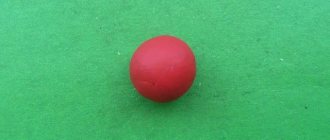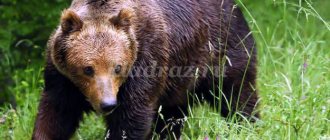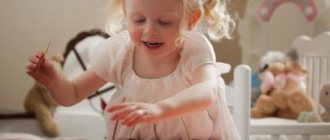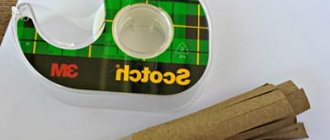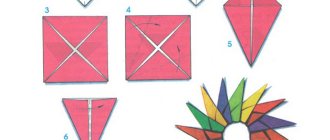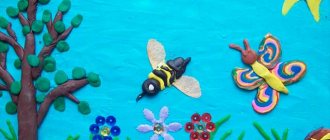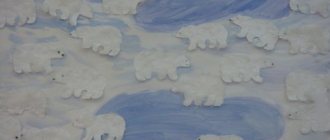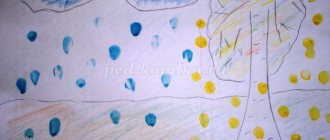Summary of a lesson on application in the first junior group of a preschool educational institution
Lesson summary for the first junior group “Decorating a hat for Mishka.”
Author : Zolotukhna Nadezhda Gennadievna MDOU No. 113 “Gulliver”, Volzhsky. Integration of educational areas : cognitive, artistic and aesthetic. Goal : to develop independent application, learn to put glue on a brush, spread ready-made shapes on oilcloth, use a napkin to remove excess glue. We fix the colors: yellow and red. Cultivate accuracy in work. Material. Hat templates according to the number of children, cut out of white cardboard, yellow circles, red circles, 2 tassels, PVA glue, oilcloth, napkins, Teddy Bear toy. Progress of the game-lesson. Prepare for class by laying out materials and tools on the table. Tell your child that Mishka (sit him on the table) really wants to have a beautiful hat, and invite the child to decorate the hat with red and yellow circles. Fizminutka Where is your hat? Well, look! Get dressed, honey, One, two, and three. Hat, hat It makes your ears warmer. Hat, hat, warm the baby. Where is your hat? It's time to go. Get ready, honey, the kids are waiting for us. Hat, hat It makes your ears warmer. Hat, hat, warm the baby. Glue the first element of the pattern onto your hat, apply glue to the second circle and, guiding the child’s hand, help him stick it on. Then stick a circle and help your baby do the same. Offer to glue the last circle in the pattern to the child yourself. After finishing work, enjoy the beautiful hat with Mishka. Play with her. Say again: “This is a red circle. This is a yellow circle." Even if the baby cannot repeat these words after you, he will definitely remember them. The duration of the lesson is no more than 10 minutes. Organize an exhibition and praise the children!
We recommend watching:
Summary of a game (integrated) lesson on environmental education for the 2nd junior group. A summary of the GCD in the junior group on traffic rules. A synopsis of the GCD on social and communicative development for the 2nd junior group. A synopsis of the GCD for physical education in the second junior group.
Similar articles:
Lesson summary for an early age group. Vegetables: turnips and carrots
Lesson summary for an early age group. Vegetables: beets and potatoes
Lesson summary for an early age group. Fruits: lemon and orange
Lesson summary for an early age group. Cat with kittens
Summary of a lesson in an early age group on a winter theme. Hare and fox
Notes on application in the 2nd junior group “Decoration - felt boots”
Notes on application in the 2nd junior group “Decoration - felt boots”
Program content:
“Artistic and aesthetic development”:
1. Strengthen in children the skill of spreading glue on an object and carefully gluing it. Use the acquired skill when creating a pattern to decorate a felt boot.
2. Continue to teach children how to position the pattern correctly and use a napkin when making appliqué.
"Social - communicative":
3. Activate the subject dictionary on the topic “Shoes”, naming geometric shapes. Form an explanatory speech.
"Cognitive development":
4. Develop visual perception, imagination, and the ability to establish cause-and-effect relationships.
"Physical development":
5. Develop fine motor skills of the fingers.
Methods and techniques.
Game situation: the arrival of the dog Sharik to the group, riddle, pictures, questions, explanation of the teacher, clarifications, additions, samples, practical activities, reminders, encouragement.
Health-saving technologies: changing static and dynamic poses, taking into account individual characteristics, finger gymnastics.
Progress of the lesson.
I. - Guys, Sharik came to visit us today and brought an interesting picture. Look at her.
-What do you see on it? (Fence, and legs under the fence).
-What are you wearing on your feet? (Felt boots).
- How many children do you think were hiding behind the fence? (2)
- How did you guess? (Close their eyes, open them - another picture).
-Did you guess correctly?
-Who do you see here?
Look at the bright colorful clothes the children have and the colorful hats they wear. What about felt boots? Are they patterned? (No) .
- Let's teach the kids how to decorate felt boots.
II. - Look how beautiful the pattern is (the teacher displays samples of the drawings).
-What does the pattern look like? (For the New Year tree).
— What geometric shapes is the pattern made of? (From triangles and circles).
— What color are the triangles? (green)
-What color are the circles (yellow, blue, red)
— A felt boot has a toe, a heel, and what part is the pattern on? (in the middle).
III. They sat down on the chairs.
— In front of you are felt boots and triangles.
- What should we do next? (spread with glue).
— How do we spread the glue? (Demonstration of sticking, explanation).
- Glue a large triangle at the bottom, a medium triangle at the top, and a small one at the very top. Glue from bottom to top..
Finger gymnastics “Herringbone”.
IV. Execution of work.
V. Summary of the lesson
- Let's make an exhibition of your works and look at them. Who got the most neat, bright, even pattern?
Author: Pryakhina Irina Olegovna
Unregulated activity “Man-made world: clothes and shoes”
Communication “Man-made world: clothes and shoes”
Monday
Reasoning “What are clothes made of”
Goal: developing ideas about the variety of clothing, the properties and qualities of objects.
Tuesday
Conversation “How girls and boys dress”
Goal: developing awareness of one’s gender identity.
Wednesday
Conversation about the work of a seamstress and shoemaker
Goal: developing ideas about the work of adults as a way of creating objects that people need.
Thursday
Conversation “How we notice disorder in clothes and correct it”
Goal: developing an idea of the need for self-service.
Friday
Sketch “Let's go through the mud” (depicting disgust)
Goal: to cultivate a caring attitude towards clothes and shoes.
Cognitive practical activity “Man-made world: clothes and shoes”
Monday
Examining the fabrics from which clothes are made
Goal: developing the ability to recognize the properties and qualities of objects.
Tuesday
Observing passersby (what they are wearing)
Goal: developing the ability to notice patterns and dependencies of objects and phenomena (if it’s cold, you need warm clothes).
Wednesday
Weather monitoring
Goal: developing the ability to determine the time of year based on characteristic features.
Thursday
Observation "Autumn Shoes"
Goal: developing the ability to notice the dependence of the choice of shoes on the weather (if it rains, you need to put on rubber boots).
Friday
Solving riddles about clothes and shoes
Goal: to consolidate ideas about the variety of clothes and shoes.
Game activity “Man-made world: clothes and shoes”
Monday
Didactic game “dress the doll for a walk”, “Undress the doll after the walk”
Goal: to reproduce in the game actions with toys related to everyday life.
Tuesday
Didactic game “Let’s show Mishka how to dress so as not to catch a cold”
Goal: formation of an algorithm for undressing and dressing.
Wednesday
Didactic game “Let’s iron the doll’s dress”
Goal: developing an understanding of clothing care
Thursday
Didactic game “When is this worn?”
Goal: strengthening the ability to establish a relationship between weather conditions and clothing.
Friday
Didactic game “What’s extra?”
Purpose: comparison of objects by function and purpose.
Artistic activity “Man-made world: clothes and shoes”
Monday
Looking at pictures of clothes and shoes
Goal: developing the ability to see a variety of items of clothing and footwear, to recognize their properties and qualities.
Tuesday
Reading works: “Our Little Masha”, “Shoes” by A. Barto, “My Teddy Bear” by Z. Alexandrova, “Whose Shoes?” N. Pavlova
Goal: introducing children to accessible literary works, developing the ability to answer adult questions.
Wednesday
Listening to the song “Mom Lesha bought excellent galoshes”
Goal: development of the ability to distinguish the nature of music.
Thursday
Listening to a fragment of P. Tchaikovsky’s work “The Seasons” (autumn) with free movements to the music
Goal: development of the ability to distinguish the nature of music.
Friday
Independent art activity with coloring books “Clothes”
Goal: development of the ability to hatch in different directions.
Shoes and hats. Lesson in the younger group
Approximate Basic Educational Program Age group: junior Theme of the educational activity “Shoes and hats” Direction of development – cognitive, speech, artistic and aesthetic. Goal: to create conditions for the formation of general concepts of hats and shoes. Tasks:
- contribute to the accumulation of ideas about hats and shoes.
- To develop the ability to find them in the surrounding (specially created) environment.
- Cultivate a neat, caring attitude towards shoes and hats.
Types of activities: gaming, communicative, motor, visual (drawing), musical. Forms of organization – group. Forms of implementation of children's activities:
- Speech outdoor game “Boots”
- Solving a problem situation
- Painting a boot
Equipment Demonstration - pictures of hats, Panama hats, scarves, baseball caps, felt boots, rubber boots, shoes. Handout – boot template, colored pencils. GCD move
— Guys, do you like to solve riddles? - Yes. Today I will tell you a few riddles, and you try to guess them.
- And in the frost and in the cold
She will always save you, So that your health is not shaky. Put... (a hat) on your head.
- Put it on my head
And run on the hottest day, And if you take it off, mom is unhappy, I am a summer hat (Panama hat).
- Warm, comfortable, keep your feet warm,
They allow you to walk through the snowdrifts for a long, long time (felt boots).
- If it rains we don't bother -
We splash around briskly through the puddles. The sun will begin to shine - We should stand under the coat rack (rubber boots).
-Well done boys! Guessed all the riddles. - Now look and tell me what you see in the pictures? (panama hat, scarf, hat, baseball cap). -What is this all called? — That's right, hats. -What do you see in these pictures? (boots, shoes, felt boots). -What is all this called? - Yes, these are shoes. - Guys, what are hats for? — Put it on your head to keep it warm or to prevent the sun from baking your head. -What are shoes for? - So that your feet don’t freeze, so that they are warm. So that your feet don't get wet. To avoid hurting your feet. - Guys, now take one picture at a time, and where the hat is, put the hats. And where the boot is - shoes. - Well done, everyone completed the task! - Now let’s stand in a circle and play the game “Boots.” You've dressed your feet in new boots, you walk, little feet, straight along the path. You walk, stomp, don’t splash in puddles, don’t walk into the mud, don’t tear your boots. - Guys, come in and take your seats. — Tell me, what are shoes made of? - Made of leather, rubber, fur. — Yes, they use different materials to make the shoes durable and comfortable. —What are the hats made of? — From fabric, yarn, fur. — Yes, also from different materials. — Guys, tell me, how should we handle both hats and shoes? - Yes, be careful, try to be careful, don’t get them dirty or tear them. - And now I invite each of you to decorate the boot. Take a pencil of any color, and music will help you in your work. - Well done boys! What beautiful boots you have made. Everyone did their best. Did you like it today? What exactly did you like? In the evening, you can show the boots to your mothers and tell them what new you learned today.
Tasks:
Teach children to create applique images of clothing: a dress - by cutting a rectangle at the edges, trousers - by the method of broken and applied appliqué. Arouse interest in composing clothing items for boys and girls. Develop a sense of form and composition.
Develop communication skills and interest in co-creation.
Material:
Clothes illustrations. Books, pictures, illustrations about clothes for viewing. paper dolls boy and girl and clothes for them, scissors, colored paper, PVA glue, napkins, colored pencils.
GCD move
Involvement in activities
- Guys, let's look at each other, what are you wearing? What beautiful dresses, skirts, and pants you are wearing. And I have images of a girl and a boy on paper, I also wanted to make beautiful clothes for them, but I had time to cut them out, I only made blouses, and I didn’t have enough time for the rest, maybe you can help me dress up the dolls?
Work on the topic
Conversation “What kind of clothes do boys wear, what kind of clothes do girls wear”
What clothes do boys wear? Guys, what clothes do girls wear? Let's make trousers for the boys and skirts for the girls.
Preparing material for work
- What do we need for this? (Colored paper, glue, glue brushes, scissors). Now you and I will take chairs and take a seat at the table. On everyone’s table there are silhouettes of a boy or a girl, blouses cut out of colored paper, and sheets of colored paper for making a skirt or pants. The leaves are smaller for the skirt, and larger for the pants.
Demonstration of the teacher, direct performance of the work
In order to make a skirt, you need to cut the edges diagonally so that the edge at the top is narrower than the bottom (demonstration by the teacher).
In order to make panties, you also need to cut the edges diagonally so that the edge at the top is narrower than the bottom, and then make a slit between the legs, because there are two legs.
Now let's take material for each, girls make an outfit for a girl, and boys for a boy. First we will prepare the trousers and skirts, and then we will glue everything on. (Independent work of children, individual assistance from the teacher). Look what beautiful outfits our boys and girls have turned out, let's come up with a name for them, but the hair and shoes are a bit undressy, maybe we can color them? (We are working with colored pencils).
GCD result
Questions for children:
What beautiful dolls did you make, who made them so beautiful? (Children's answers). How did you do that? What was difficult for you to accomplish? Do you like your job?
I also really like what you did, it turned out very beautiful, and now let's hang your work at the exhibition so that your parents can also see how well you did today.
